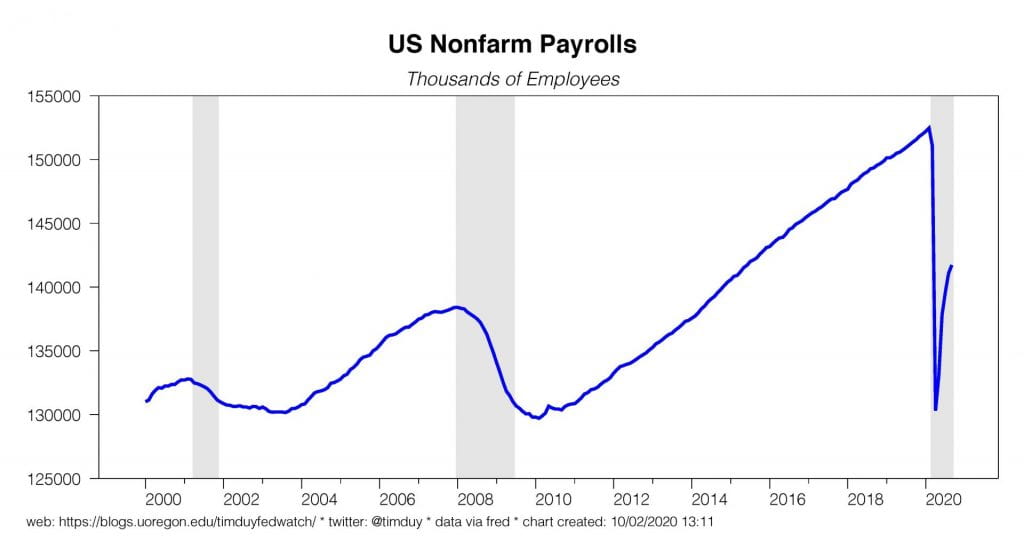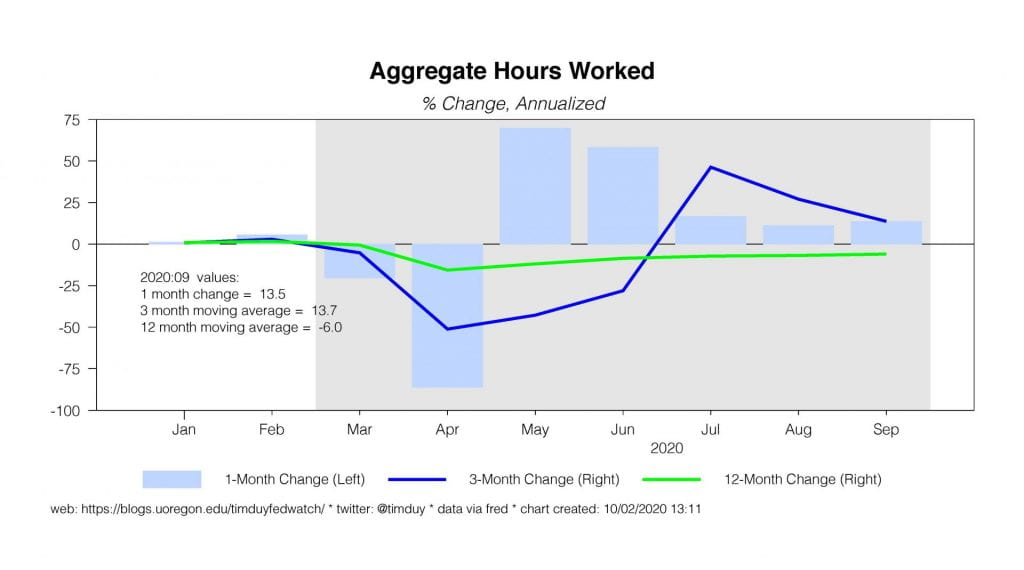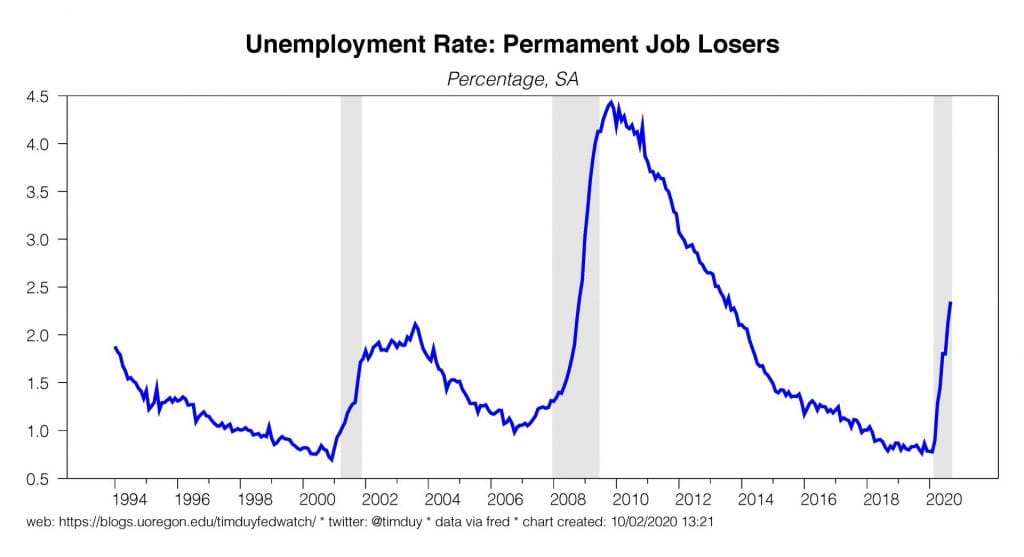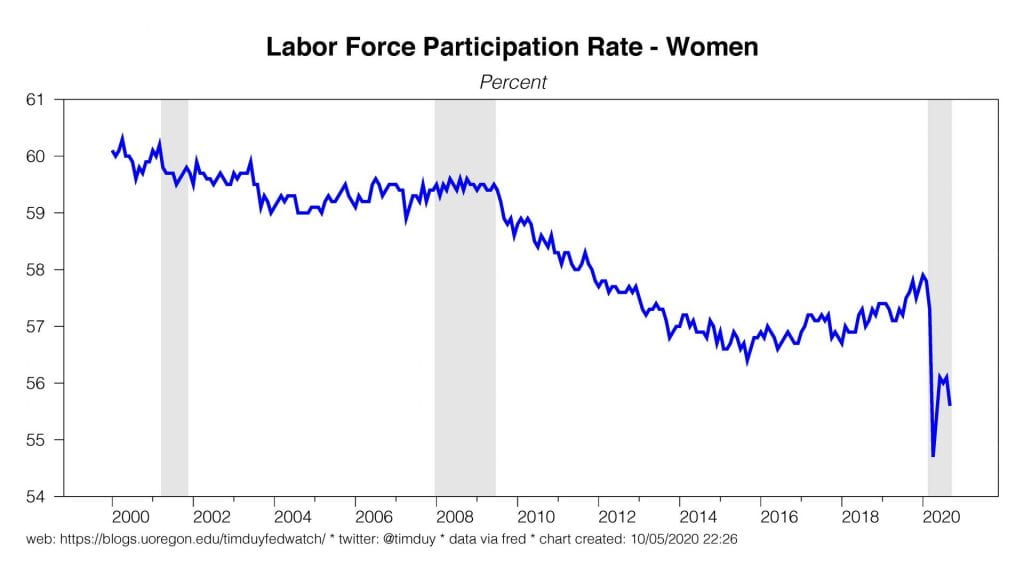The September employment report was almost lost in the news that President Donald Trump and a number of other high-ranking Republicans were diagnosed with Covid-19. Jobs continue to grow at a historically rapid rate, but that rate continues to decelerate as the initial bounce back of activity fades into memory. The employment report leaves the Fed in its current holding pattern. Although the unemployment rate continues to descend, it both remains too high to be anything approaching a hot job market and even if it did it would be largely irrelevant in the absence of actual inflation at or above 2%.
Four key takeaways:
- Jobs growing but growing more slowly:
Two narratives are developing. One is that the slowdown represents a fragile economy vulnerable to renewed setbacks. That is the narrative we heard for many years following the last recession and stems from a focus on large scale layoffs while ignoring the fact that net new hires in the private sector were still 877k in September. The other narrative is that the expansion is more likely than not still self-sustaining even if the pace of recovery is slower than we might like prefer. I would suggest market participants focus on the latter narrative.
- Aggregate hours growth, however, accelerated:
Accelerating hours growth suggests that wage growth may be faster than headline job growth suggests. This would help compensate for declining fiscal support, although as of August saving rates were still 14.1%, or roughly twice pre-pandemic norms, so there is plenty of spending power still available. A key problem is that the pandemic still limits spending in a portion of the economy, which gets us to the next takeaway…
- Permanent job losses continue to rise. As time passes, it has become evident that sectors of the economy most impacted by the pandemic will not recover quickly. Consequently, we should anticipate the number of permanent job losses to mount as firms that struggled through the summer collapse either continue to struggle or collapse in the fall and winter.
Most likely to remain heavily impacted will be the leisure and hospitality sector:
 With cold weather already settling in, Covid-19 cases are rising in many states with colder climates; see this from Reuters. Firms that were able to survive on outdoor dining this summer will be under severe pressure this winter when that no longer becomes a viable option. We won’t have a full recovery in this sector until the virus is better contained. And even at that point, recovery will be hampered by ongoing firm closures and a reallocation of labor to other resources.
With cold weather already settling in, Covid-19 cases are rising in many states with colder climates; see this from Reuters. Firms that were able to survive on outdoor dining this summer will be under severe pressure this winter when that no longer becomes a viable option. We won’t have a full recovery in this sector until the virus is better contained. And even at that point, recovery will be hampered by ongoing firm closures and a reallocation of labor to other resources.
Another lingering problem is that downtown areas dependent on office workers also face a restructuring. It is more likely than not that at least partial work-from-work will become the norm going forward (I had one business owner tell me their employees would flat out quit if they had to return to the office full time). Between that and more limited business travel, downtown areas are facing a very different future than that of a year ago.
- Lack of child care options and online school is hammering labor force participation among women. Women left the labor force in droves last month, down 617k and pushing labor force participation among that group down to 55.6%, almost 5 percentage points lower than the April 2000 high of 60.3%:
Exiting the labor force even if temporary will for many of these women have negative long term effects on their careers. For the economy has a whole, this is a negative supply side shock; we know that firms on net are adding workers at the same time conditions are forcing many out of the labor market. This will have a restraining impact on growth if, when the pandemic is under control, the child care industry remains damaged by firm closures.
Trump’s hospitalization may accelerate passage of another fiscal support package. That said, I am wary about holding my breath as the Senate has remained the stumbling block more than Trump. It is probably too late for a new fiscal package to have an impact on the election (I had thought goosing the economy ahead of the election was a no-brainer, but that would have been helpful in July not now). NBC is reporting that Biden’s lead in its poll has jumped to 14 points. Trump’s performance at last week’s debate is proving disastrous for his campaign.
Update: Via ForexLive, Senate Majority Leader Mitch McConnell says “we’re closer” on a stimulus deal.
Bottom Line: This is a familiar place, an expansion that is self-sustaining but the recession has left the economy in enough of a hole for people to argue that the expansion is not self-sustaining.













